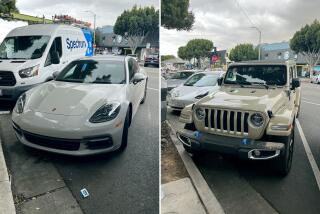Spotting the Paint Problem Is Easy, but What’s the Solution for Owner?
- Share via
Question: I hand-wash my car to keep the hot water and heavy detergent at the carwash from dulling the finish. Recently, yard sprinklers left my hood covered with water spots. I tried washing the hood--twice--and then I tried waxing it. I even tried Windex. Nothing got the spots out. Should I take it to the carwash, or is there another solution?
J.C.
*
Answer: Hard-water spots typically show up on a dark paint as the minerals suspended in water are deposited as the water evaporates.
Southern California water is typically quite “hard” indeed, with a lot of calcium and other minerals that can stain paint, leave crusty deposits on pool tile and stain windows of homes when they get splattered by sprinklers.
After some time, the minerals etch into whatever they land on, damaging the surface. Even glass, which is highly resistant to chemicals, can be etched in the long run by hard-water deposits.
The paint on your car is no match for this stuff. So it’s best to keep it out of the path of sprinklers. But you should be able to get rid of moderate mineral deposits that haven’t damaged the paint.
Wax will not get rid of embedded minerals or even dirt, for that matter. Waxing a dirty car is generally a bad idea, because you are encasing crud into the wax. A cleaner-wax--which contains wax, fine polishing grit and solvent-based cleaners--is a better bet. You’ll want to shop for a product that specifies that it’s a cleaner-wax.
If that doesn’t cut it, the next step would be to try a polishing compound, typically a white paste that contains very fine polishing grit and is usually able to dislodge crud that embeds into the paint.
An even more effective option might be the clay bar systems found at most auto suppliers. These use a mound of special clay that is able to shear off crud, dirt, soot, metal grime and other stuff that embeds itself into the paint.
The user sprays the car’s painted surface with a cleaner fluid, which is typically supplied with the clay bar kit, and then rubs the bar lightly across the paint, one small section at a time. The action is supposed to leave the paint glassy smooth. The next step is to apply a high-quality wax.
*
Q: I drive a 1987 Mercedes-Benz 420SEL, which runs like a Swiss watch except for one annoying problem. When I shift from drive to reverse, it seems like it takes forever--about three seconds--for the transmission to engage. The same thing happens from reverse to drive. I’m told by my dealer that this is normal. I don’t buy it.
R.D.W.
*
A: A long delay in a transmission’s engagement from reverse to drive, as you are experiencing, is typical of a system that has a torque converter problem.
The torque converter is the fluid clutch that connects the engine to the transmission, allowing the engine to idle at low speed without moving the car but engaging the transmission at higher speeds.
Low transmission fluid is often first noticeable when there is a few-second delay between shifting into gear and feeling the transmission engage. Sometimes a faulty pump in the transmission will give the same sensation.
The problem you mention is not a known Mercedes-Benz defect. The company did introduce a modified vacuum modulator, which measures engine load and helps determine when the transmission should shift to a different gear. A problem with the modulator could cause harsh shifting, which may be related to the issue you are raising. The new part was outlined in Technical Service Bulletin 27-90, as reported by Mitchell On-Demand automotive publishing.
If the condition has been present for a long time--10,000 or 20,000 miles, say--it may indeed be normal in the sense that it is not a precursor to a transmission failure.
But if it is something more recent, you should monitor it carefully. Pay close attention to your transmission fluid level and make sure the fluid remains clear. Fluid that looks or smells burnt is a sign of incipient failure.
*
Ralph Vartabedian cannot answer mail personally but responds in this column to automotive questions of general interest. Please do not telephone. Write to Your Wheels, Business Section, Los Angeles Times, 202 W. 1st St., Los Angeles, CA 90012. E-mail: ralph.vartabedian@latimes.com .






